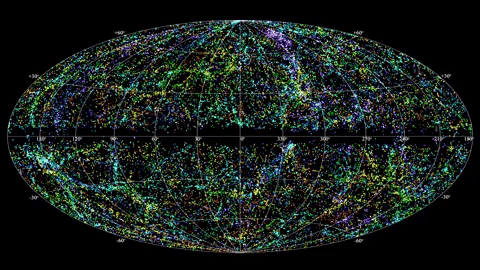
In June, astronomers discovered Fast Radio Burst 121102 had a 157-day repeating schedule. Right on schedule, scientists have detected activity from the mysterious radio signal.
The findings, published in The Astronomer’s Telegram, suggest “that this repeater [FRB 121102] is likely in another active phase,” the researchers wrote.
FRB 121102, which has been observed since 2016 by the Lovell Telescope in the U.K., was discovered to have a 157-day repeating pattern. It shows activity for approximately 90 days and then goes silent for 67 days, according to the June study.
![An animation shows the random appearance of fast radio bursts (FRBs) across the sky. Astronomers have discovered about 100 since 2007. (NRAO Outreach/T. Jarrett [IPAC/Caltech]; B. Saxton, NRAO/AUI/NSF)](https://static.foxnews.com/foxnews.com/content/uploads/2019/08/fast-radio-burst.gif)
An animation shows the random appearance of fast radio bursts (FRBs) across the sky. Astronomers have discovered about 100 since 2007. (NRAO Outreach/T. Jarrett [IPAC/Caltech]; B. Saxton, NRAO/AUI/NSF)
CLOSEST EVER, MYSTERIOUS ‘FAST RADIO BURST’ FOUND 30,000 LIGHT-YEARS FROM EARTH
However, the new findings slightly tweak that time frame, suggesting FRB 121102 has an on-off time frame of approximately 156.1 days.
The researchers, from the National Astronomy Observatory of China, detected “at least 12 bursts” from FRB 121102 on Aug. 17. They expect the active part of the signal to end between Aug. 31 and Sept. 9.
“Alternatively, if the source is continuously on after the projected turning-off time, it suggests that the putative period of the source is not real or has evolution,” the scientists wrote. “We encourage more follow-up monitoring efforts from other radio observatories.”
FRB 121102 is the second fast radio burst known to have a repeating schedule after FRB 180916.J0158+65 was found to have a 16-day repeating pattern in February.
It’s unclear exactly why FRB 180916.J0158+65 repeats, but researchers have suggested it could be because it is orbiting a compact object, for example, a black hole, causing its pattern to repeat. It’s also possible that it could be coming from a binary star system, but more research is needed.
ANOTHER FAST RADIO BURST IN DEEP SPACE THAT REPEATS HAS BEEN FOUND AND SCIENTISTS ARE STUNNED
It’s unknown how common FRBs actually are and why some of them repeat and others do not; most of their origins are also mysterious in nature.
Some researchers have speculated they stem from an extraterrestrial civilization. But others, including the Search for Extraterrestrial Intelligence Institute, or SETI, have said that explanation “really doesn’t make sense.”
MYSTERIOUS FAST RADIO BURST UNVEILS ‘GALAXY’S TRANQUIL HALO’
They come from all over space “and arranging cooperative alien behavior when even one-way communication takes many billions of years seems unlikely — to put it gently,” SETI wrote in a September 2019 blog post.
First discovered in 2007, FRBs are relatively new to astronomers and their origins are mysterious. According to ScienceAlert, some of them can generate as much energy as 500 million suns in a few milliseconds.
In July 2018, an FRB that hit Earth was nearly 200 megahertz lower than any other radio burst ever detected.

